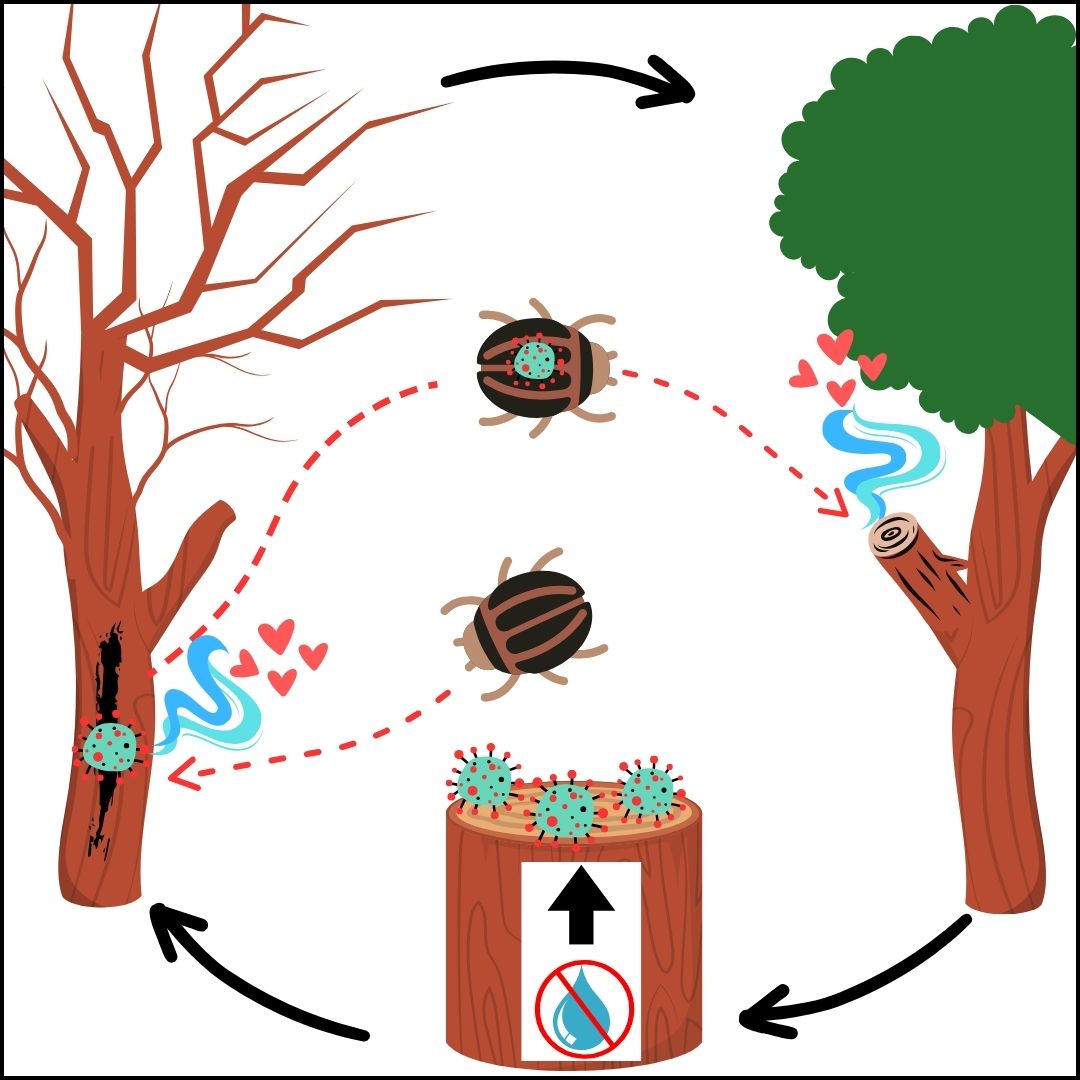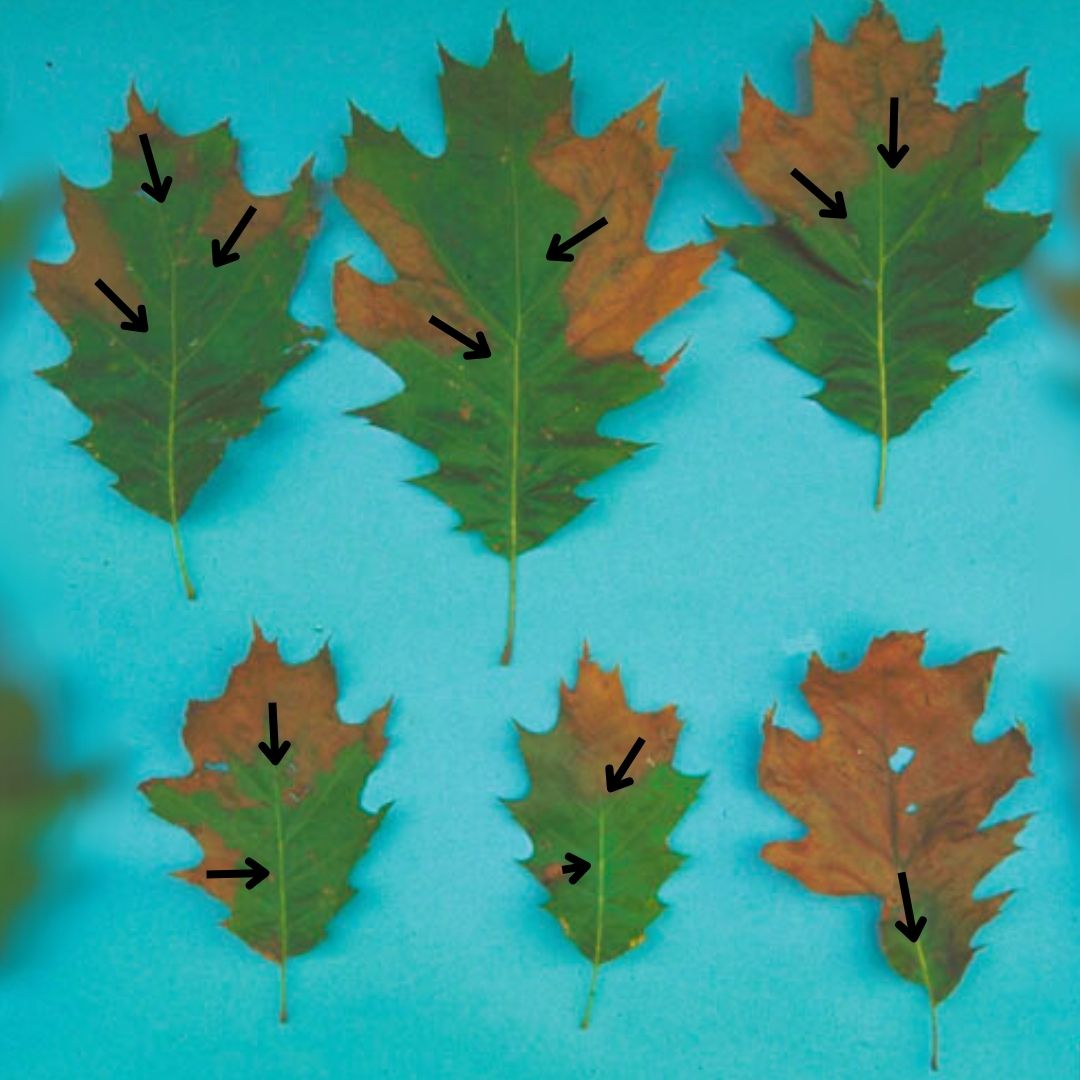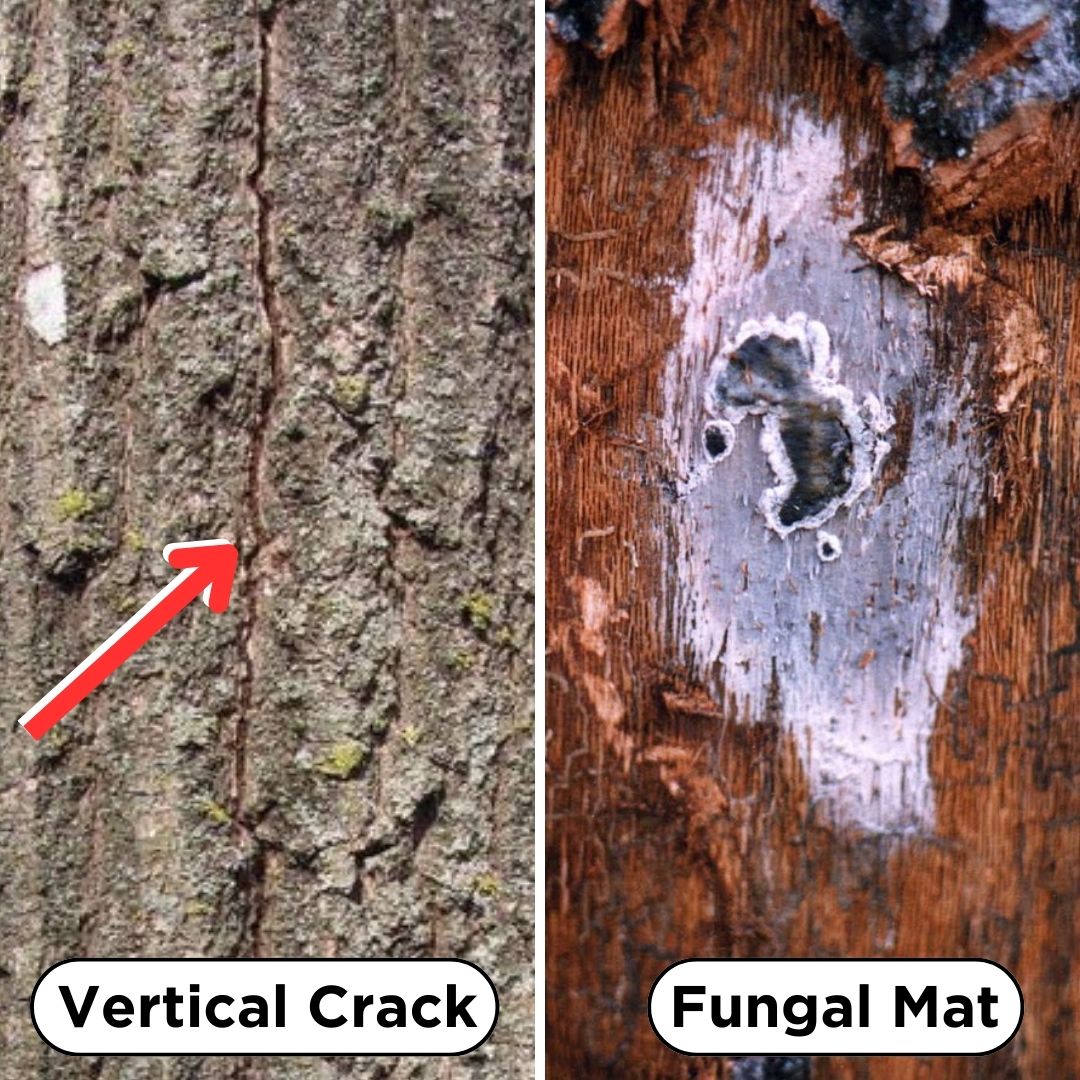Oaks are large, long-lived trees that support a variety of life above and below ground with their wide, shading canopies, spreading roots and nutritious acorns. Their size and longevity also enable them to provide a range of ecosystem services such as carbon sequestration (capturing and storing carbon dioxide), soil stabilization and temperature regulation. These characteristic features make them a keystone species that hold our forest ecosystems together. Culturally, oaks have been admired for their strength and durability, but these traits have come under threat from a new invasive pest, which could have a devastating impact on our native oak populations. Here is what you need to know about oak wilt.
Q: What is oak wilt?
A: Oak wilt is a vascular disease caused by an invasive fungus Bretziella fagacearum. The fungus grows inside the living vascular xylem tissues (i.e. the tree’s plumbing system) of oak trees, disrupting the flow of water and nutrients between the roots and the canopy (the aboveground portion of the tree). When these vital resources are cut off, the tree wilts and dies.
The origin of the fungus is unknown, but it is believed to have been present in North America since the start of the 20th century. In 2023, oak wilt was detected for the first time in Canada in the Niagara Region.

The xylem is made up of living tissues (sapwood) and inactive tissues (heartwood) forming what we know as wood. The lighter-coloured sapwood is newer wood, responsible for moving water and nutrients up from the roots to the canopy. The darker-coloured heartwood is retired sapwood, helping provide stability to the tree. Oak wilt grows in the living sapwood tissues.
Q: Are all oak trees affected?
A: All oak trees are affected by oak wilt; however, some species are more susceptible than others. There are two main groups of oaks in Ontario: red oaks and white oaks. Species of the red oak group, such as red oak and black oak, are often more vulnerable to the oak wilt infection, whereas species of the white oak group, such as white oak, bur oak and swamp white oak, are generally more resistant.

Oak species of the white oak group are generally more resistant to oak wilt because they are better able to restrict infections compared to those of the red oak group. As a result, mortality is often seen quicker and more frequently in red oak species as infections can spread faster. It is important to note that red oak species typically die in the same year, or the following year of infection, whereas it may take several years or more before white oak species succumb to oak wilt.
Q: How does oak wilt spread?
A: There are two primary ways through which oak wilt naturally spreads: aboveground by insects and below ground by root grafts (interconnected roots). Humans also play a role in spreading oak wilt by moving infected wood and wood products like firewood.
Aboveground, native sap beetles covered in oak wilt spores inadvertently move the fungus from infected trees to healthy trees. When an oak tree is wounded (e.g., after storms, pruning, fire, etc.), the newly exposed wood emits chemicals and sap that attract the beetles. When the spore-covered beetles arrive to feed, the spores transfer to the vascular tissues of the tree and spread. Red oak species lack the natural defense mechanisms to protect their living tissues from the spread of oak wilt, whereas white oak species are better able to isolate the fungus, minimizing damages and sometimes death. Because the fungus quickly spreads through red oak species, death typically occurs within the same year or following year of infection, whereas it may take several years or more before white oak species succumb to oak wilt.
Upon death of large red oak species, the fungus continues growing underneath the bark, creating a large patch of fungus (called a spore mat or pressure pad). The mats exert pressure on the bark, eventually cracking it open, allowing the underlying fungus to release its fruity scent to re-attract native sap beetles. The fungal spores stick to the beetles as they feed, thus restarting the cycle when they visit the wounds of uninfected oak trees.
Underground, oak wilt can spread through interconnected oak roots. Tree roots typically extend two to three times the width of the canopy and for large-growing oaks, this means roots that extend long distances. With such wide-spreading root systems, the roots of neighbouring trees will inevitably grow close together. If neighbouring roots are from the same species, they can graft (join together) their roots, allowing them to share vital resources. Unfortunately, fungal pathogens like oak wilt are also shared.

Aboveground transmission cycle. Native sap beetles are attracted to the scent of fresh wounds on uninfected trees and the fruity pressure pads on infected, dead oak trees. The beetles become covered in sticky fungal spores when visiting the infected trees and transfer them to the exposed vascular tissues of wounds on otherwise healthy trees.
Q: What are the signs and symptoms of oak wilt?
A: While there are many signs and symptoms of oak wilt, three important ones include:
Leaf Discolouration: Oak wilt causes green leaves to discolour, wilt and prematurely drop before autumn. This symptom is often rapid in red oak species and slower in white oak species. Because this symptom is not unique to oak wilt, other signs and symptoms are needed to confirm infection.

The leaves of oak wilt-infected trees become brown, dull green or yellow before wilting and prematurely dropping. Discolouration begins at the outer edges of the leaf and moves towards the middle and starts from the top of the tree and moves downward.
Vascular Discolouration: A more reliable symptom of oak wilt is darkly stained sapwood. If staining is seen when cutting into wood, samples can be sent for genetic testing to confirm.

Oak wilt produces a dark stain in the sapwood, which is seen as a circle in the cross-section of a branch (top image) or as streaking when bark is scraped back along a branch (bottom image).
Vertical Cracks and Scented Spore Mats/Pressure Pads: In large, dead red oak species, spore mats/pressure pads create vertical cracks in the bark. Underneath, the distinct grey, black or white fungus gives off a characteristic fruity scent and is a sure sign of oak wilt.

Oak wilt spore mats/pressure pads create vertical cracks in the tree trunk or large branches (left image). Beneath the cracked bark, the fruity-smelling, grey, white or black fungal mats can be found (right image).
Q: How can I help prevent the spread of oak wilt?
A: There is no cure for oak wilt, so prevention and early detection are the most effective and low-cost solutions for managing oak wilt. Five things you can do to help prevent or reduce spread are to:
- Prune oak trees in the winter. Do not prune in April through October as this is the most active time for spores to spread.
- Paint wounds and disinfect tools. Apply latex or commercial tree paint to the fresh wounds of oak trees to prevent the arrival of sap beetles. Disinfect all pruning tools after each use to avoid cross-contamination. Please note that LEAF does not recommend using wound paint on other tree/shrub wounds as it can interfere with the tree’s ability to naturally heal itself.
- Do not move firewood. Buy and burn wood locally.
- Learn how to identify oak wilt and stay up to date. The Invasive Species Centre and the Canadian Food Inspection Agency (CFIA) have accessible learning resources and current information on the status of oak wilt in Canada.
- Report any suspected oak wilt infections. You can report suspected oak wilt to: the CFIA; the Invasive Species Hotline at 1-800-563-7711; or the EDDMapS app or website.
Q: Is it OK to plant oak trees?
A: It may or may not be advisable to plant a new oak tree on your property depending on some factors, but an ISA certified arborist can help you navigate the decision-making process by:
- Assessing your growing conditions like soil, sunlight, space to determine if an oak tree would be suitable for your property.
- Recognizing opportunities for oak wilt spread (e.g., identifying existing nearby oak trees, which could present an opportunity for root grafting in the future).
- Recommending less susceptible oak species or alternative planting options (e.g., suggesting a more resilient white oak species over a red oak species).
- Providing education on how to protect your oak trees from oak wilt (e.g., information on when is the best time to prune your tree).
Jess Wilkin is the Residential Planting Programs Operations Supervisor and an ISA certified arborist at LEAF.
LEAF offers a subsidized Backyard Tree Planting Program for private property. The program is supported by the City of Toronto, the Regional Municipality of York, the City of Markham, the Town of Newmarket, the Regional Municipality of Durham, the Town of Ajax, the Township of Brock, the Municipality of Clarington, the City of Oshawa, the City of Pickering, the Township of Scugog, the Town of Whitby and Ontario Power Generation.
